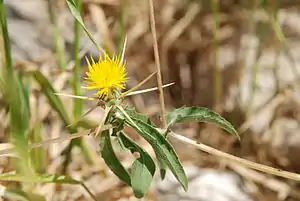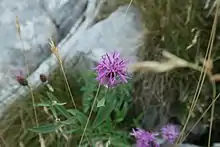Flockenblumen
Die Flockenblumen (Centaurea) bilden eine Pflanzengattung in der Unterfamilie der Carduoideae innerhalb der Familie der Korbblütler (Asteraceae). Die je nach Autor etwa 260 bis über 700 Arten sind hauptsächlich in Europa, dem Mittelmeerraum und in Vorderasien verbreitet, einige Arten sind in vielen Gebieten der Welt Neophyten.
| Flockenblumen | ||||||||||||
|---|---|---|---|---|---|---|---|---|---|---|---|---|
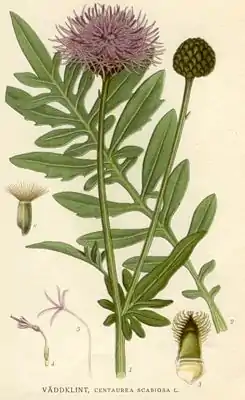
Skabiosen-Flockenblume (Centaurea scabiosa), Illustration | ||||||||||||
| Systematik | ||||||||||||
| ||||||||||||
| Wissenschaftlicher Name | ||||||||||||
| Centaurea | ||||||||||||
| L. |
Beschreibung
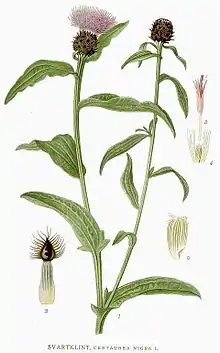
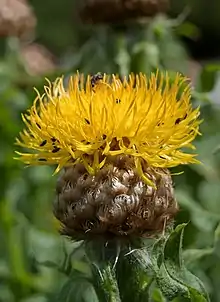
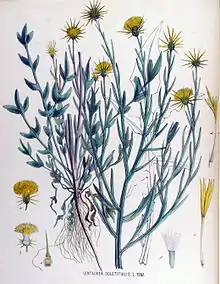
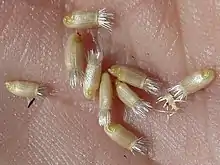
Vegetative Merkmale
Centaurea-Arten sind ein-, zweijährige oder meist ausdauernde krautige Pflanzen,[1] die je nach Art Wuchshöhen von 20 bis 300 Zentimetern erreichen.
Die wechselständig angeordneten Laubblätter sind manchmal ungeteilt, häufig jedoch fiederteilig.
Generative Merkmale
Die körbchenförmigen Blütenstände stehen einzeln oder bis zu vielen in rispig-schirmtraubigen oder rispig-traubigen Blütenständen zusammen.[1] Das Involucrum ist kugel-, ei-, glocken- oder schüsselförmig.[1] Die dachziegelartig sich überlappenden Hüllblätter besitzen oft einen häutigen Rand und artspezifische abgesetzte gefranste oder dornige Anhängsel.[1] Die Spreublätter sind borstig zerschlitzt.
Bei den Carduoideae sind, im Gegensatz zu den anderen Unterfamilien, nur Röhrenblüten vorhanden; bei dieser Gattung je Blütenkorb wenige bis viele. Bei vielen Arten sind die randlichen Röhrenblüten leicht zygomorph sowie vergrößert und steril. Die inneren Röhrenblüten sind zwittrig. Die Kronblätter sind weiß bis gelb oder rosa- bis purpurfarben. Die zwei Griffeläste sind kurz.[1]
Die spärlich fein behaarten, verkahlenden oder kahlen Achänen besitzen einen gezähnten oder glatten oberen Rand. Die Achänen besitzen einen haltbaren oder früh abfallenden Pappus, selten fehlt dieser auch völlig. Der Pappus besteht aus zwei Typen von Elementen; die äußeren Elemente sind borstenförmig und meist in selten nur einer, meist mehreren Reihen angeordnet; die inneren Elemente sind kurz und meist schuppenförmig.[1]
Chromosomensätze
Die Chromosomengrundzahlen betragen x = 8, 9, 10, 11, 12, 13 oder 15.[2]
Systematik und Verbreitung
Die Gattung Centaurea wurde 1753 durch Carl von Linné in Species Plantarum, Tomus II, Seite 909.[3] aufgestellt. Typusart war bis 2001 Centaurea centaurium L. (Großes Kentaurion, lateinisch Centaureum majus, deutsch auch Zentaurenkraut und Goldkörbchen genannt[4]). Der botanische Gattungsname Centaurea ist abgeleitet vom altgriechischen Wort kentaúreion, das auf den mythischen Zentauren (griechisch kentaur) Chiron zurückgeht, der mit der Kornblume (Centaurea cyanus) oder dem Zentaurenkraut (Centaurea centaurium) eine Wunde am Fuße des Helden Achilles geheilt haben soll.
Centaurea gehört zur Subtribus Centaureinae Dumort. (mit etwa 30 Gattungen) aus der Tribus Cardueae in der Unterfamilie Carduoideae innerhalb der Familie der Asteraceae. Der Umfang von Centaurea s. l. war deutlich größer. Viele Arten wurden beispielsweise in die Gattungen Cheirolophus Cass. (Syn.: Palaeocyanus Dostál), Cyanus Mill. (25 bis 30 Arten), Phalacrachena Iljin (2 Arten), Plectocephalus D.Don (4 Arten), Psephellus Cass. (75 bis 80 Arten) und Rhaponticoides Vaill. (30 Arten) ausgegliedert. Centaurea s. l. ist polyphyletisch.
Die Systematik der Verwandtschaftsgruppe rund um die Gattung Centaurea hat sich seit 1976 (Dostál 1976) bis (beispielsweise Susanna et al. 1995, Garcia-Jacas et al. 2000, 2001, 2006, Hilpold et al. 2014) 2020 mehrmals grundlegend verändert. Da die frühere Typusart in eine andere Gattung gestellt wurde musste sogar als neue Typusart Centaurea paniculata L. festgelegt werden.[5][6] Die Gliederung der Gattung Centaurea wurde oft verändert, beispielsweise bei Hilpold et al. 2014 gibt es drei Untergattungen in der engergefassten Gattung.[6]
In Mitteleuropa am häufigsten in der Natur zu finden ist die Wiesen-Flockenblume (Centaurea jacea). Regional unterschiedlich sind auch Skabiosen-Flockenblume (Centaurea scabiosa), Schwarze Flockenblume (Centaurea nigra), Phrygische Flockenblume (Centaurea phrygia) und weitere Arten verbreitet.
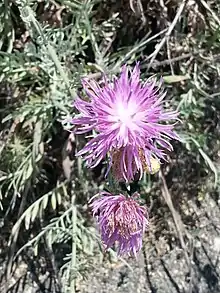 Blütenkörbe von Centaurea aeolica  Habitus von Centaurea akamantis im Habitat 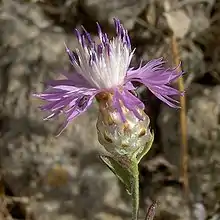 Blütenkorb von Centaurea alba 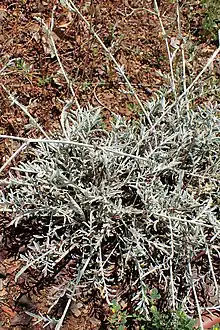 Centaurea alba subsp. huljakii  Habitus von Centaurea amblensis im Habitat 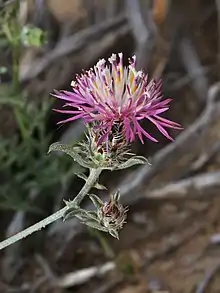 Blütenkorb von Centaurea ammocyanus 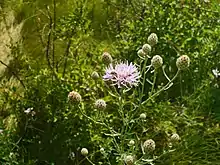 Centaurea arenaria 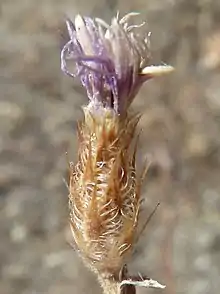 Blütenkorb von Centaurea aristata  Blütenkorb von Centaurea aspera 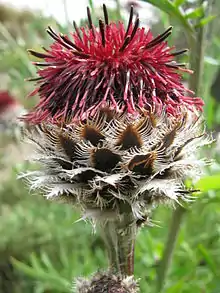 Blütenkorb von Centaurea atropurpurea 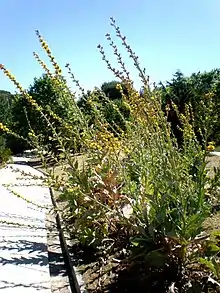 Habitus von Centaurea babylonica 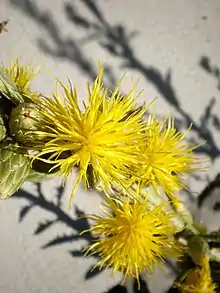 Blütenkörbe von Centaurea babylonica 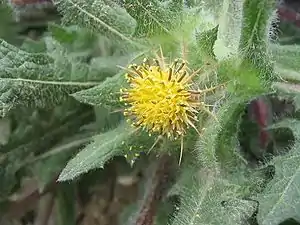 Benediktenkraut (Centaurea benedicta) 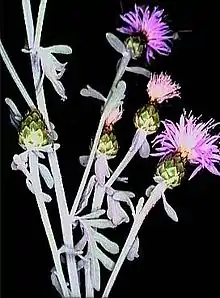 Centaurea busambarensis 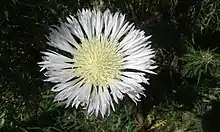 Blütenkorb von Centaurea cachinalensis 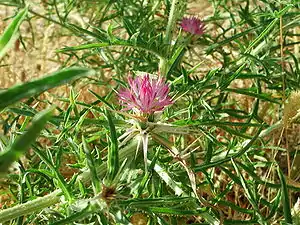 Stern-Flockenblume (Centaurea calcitrapa) 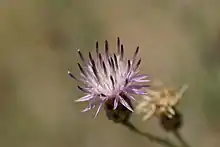 Blütenkorb von Centaurea carratracensis 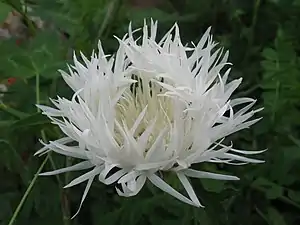 Blütenkorb von Centaurea cheiranthifolia 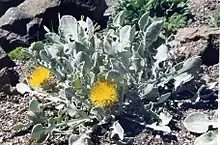 Habitus, Laubblätter und Blütenkörbe von Centaurea chrysantha 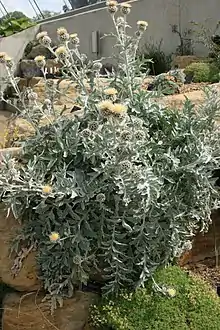 Habitus von Centaurea clementei 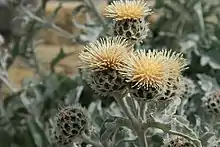 Blütenkörbe von Centaurea clementei  Blütenkorb von Centaurea collina  Blütenkorb von Centaurea cordubensis 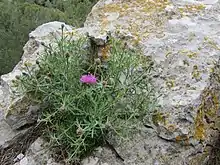 Habitus, Laubblätter und Blütenkorb von Centaurea corymbosa  Blütenkorb von Centaurea cyanoides 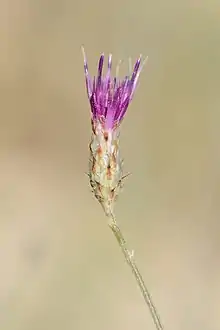 Blütenkorb von Centaurea damascena 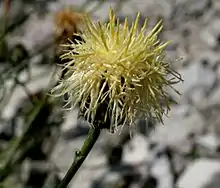 Blütenkorb von Centaurea dichroantha 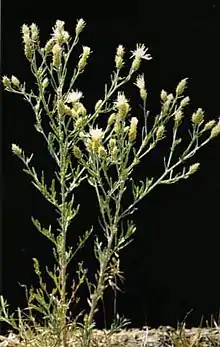 Sparrige Flockenblume (Centaurea diffusa) _D3S2_03.jpg.webp) Blütenkorb von Centaurea diluta -crop.JPG.webp) Blütenkorb von Centaurea eriophora  Blütenkorb von Centaurea galicicae  Centaurea horrida  Wiesen-Flockenblume (Centaurea jacea) 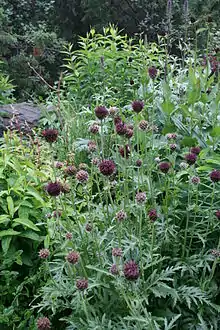 Centaurea kotschyana 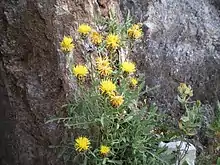 Centaurea kunkelii 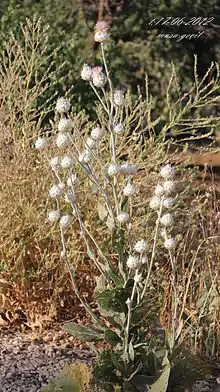 Centaurea kurdica 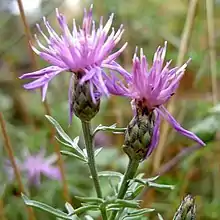 Blütenkorb von Centaurea limbata 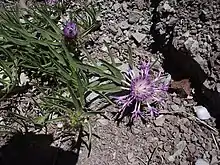 Centaurea linifolia 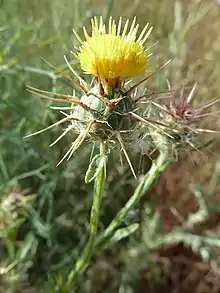 Malta-Flockenblume (Centaurea melitensis) 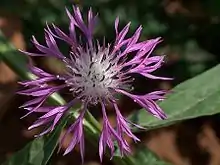 Blütenkorb von Centaurea napifolia 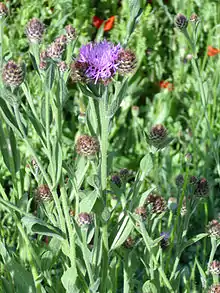 Centaurea nevadensis 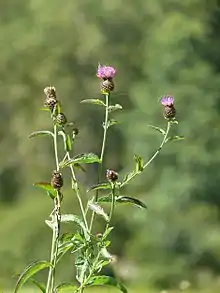 Schwarze Flockenblume (Centaurea nigra) 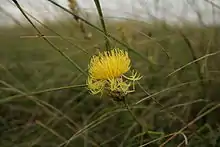 Blütenkorb von Centaurea orientalis 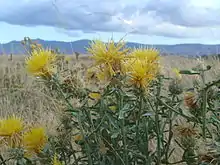 Centaurea ornata subsp. ornata 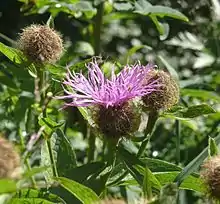 Perücken-Flockenblume (Centaurea phrygia subsp. pseudophrygia) 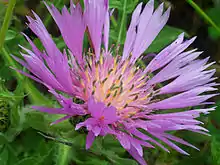 Blütenkorb von Centaurea pullata 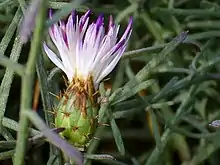 Blütenkorb von Centaurea pulvinata .jpg.webp) Zwerg-Flockenblume (Centaurea pumilio) .JPG.webp) Ragusa-Flockenblume (Centaurea ragusina) 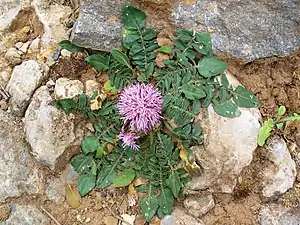 Rettichartige Flockenblume (Centaurea raphanina) 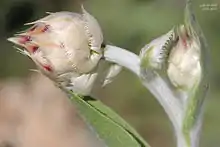 Centaurea regia subsp. cynarocephala 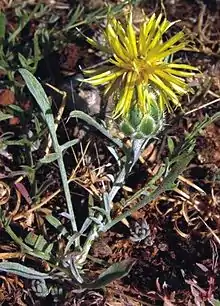 Centaurea rupestris subsp. kozanii 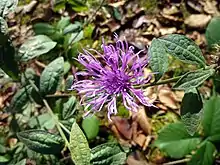 Blütenkorb von Centaurea salicifolia 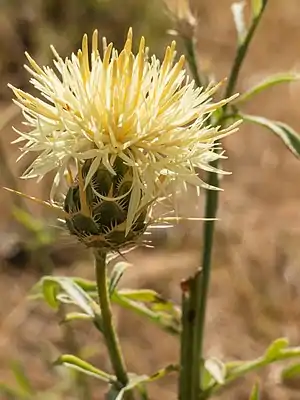 Split-Flockenblume (Centaurea salonitana) 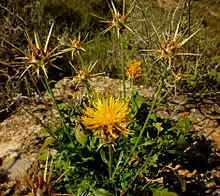 Centaurea saxicola 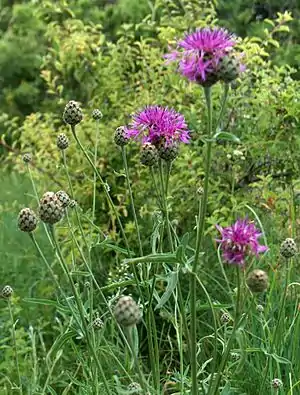 Skabiosen-Flockenblume (Centaurea scabiosa)  Sonnenwend-Flockenblume (Centaurea solstitialis) 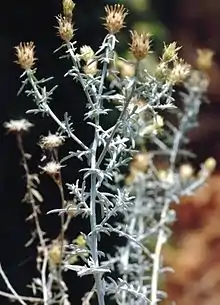 Centaurea soskae 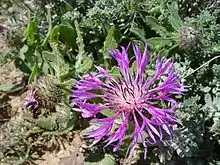 Kugelkopf-Flockenblume (Centaurea sphaerocephala) 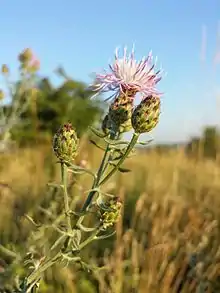 Rispen-Flockenblume (Centaurea stoebe) 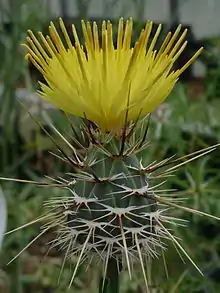 Sizilianische Stern-Flockenblume (Centaurea sulphurea) 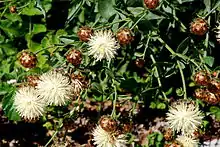 Centaurea tauromenitana 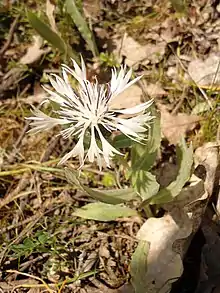 Blütenkorb von Centaurea thirkei 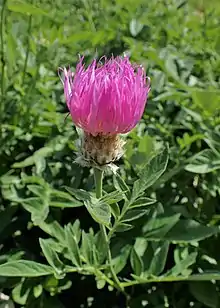 Blütenkorb von Centaurea transcaucasica .jpg.webp) Einköpfige Flockenblume (Centaurea uniflora) 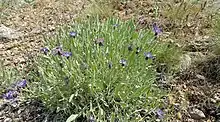 Habitus, Laubblätter und Blütenkörbe von Centaurea uysalii  Centaurea verutum
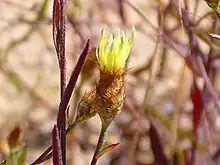 Naturhybride Centaurea ×tatayana In der Gattung Centaurea gibt es viele Naturhybriden, sie sind nicht besonders gut untersucht:[13]
|
|
Quellen
- David J. Keil, Jörg Ochsmann: Centaurea. In: Flora of North America Editorial Committee (Hrsg.): Flora of North America North of Mexico. Volume 19: Magnoliophyta: Asteridae, part 6: Asteraceae, part 1 (Mutisieae–Anthemideae). Oxford University Press, New York / Oxford u. a. 2006, ISBN 0-19-530563-9, S. 177 (englisch). (Abschnitt Beschreibung)
- Zhu Shi, Ludwig Martins: Centaurea. In: Wu Zheng-yi, Peter H. Raven, Deyuan Hong (Hrsg.): Flora of China. Volume 20–21: Asteraceae. Science Press/Missouri Botanical Garden Press, Beijing/St. Louis 2011, ISBN 978-1-935641-07-0, S. 191 (englisch). (Abschnitt Beschreibung)
- Josef Dostál: Centaurea L. In: T. G. Tutin, V. H. Heywood, N. A. Burges, D. M. Moore, D. H. Valentine, S. M. Walters, D. A. Webb (Hrsg.): Flora Europaea. Volume 4: Plantaginaceae to Compositae (and Rubiaceae). Cambridge University Press, Cambridge 1976, ISBN 0-521-08717-1, S. 254–301 (englisch, eingeschränkte Vorschau in der Google-Buchsuche).
- Núria Garcia-Jacas, Alfonso Susanna, Teresa Garnatje, Roser Vilatersana: Generic delimitation and phylogeny of the subtribe Centaureinae (Asteraceae): a combined nuclear and chloroplast DNA analysis. In: Annals of Botany. Band 87, Nr. 4, 2001, S. 503–515, doi:10.1006/anbo.2000.1364.
- Hülya Özler, Zafer Kaya, Sevil Pehlivan: Pollen morphology of some Centaurea L., Psephellus Cass. and Cyanus Miller taxa. In: Acta Biologica Cracoviensia, Series Botanica. Band 51, Nr. 1, 2009, S. 53–66 (PDF-Datei).
- Özhan Aydin, Kamil Çoşkunçelebi, Mutlu Gültepe, Murat Erdem Güzel: A contribution to taxonomy of Centaurea including Psephellus (Asteraceae) based on anatomical and molecular data. In: Turkish Journal of Botany. Band 37, Nr. 3, 2013, S. 419–427. PDF-Datei.
- A. Hilpold, Núria Garcia-Jacas, Roser Vilatersana, Alfonso Susanna: Taxonomical and nomenclatural notes on Centaurea: A proposal of classification, a description of new sections and subsections, and a species list of the redefined section Centaurea. In: Collectanea Botanica. Band 33, 2014, e001. doi:10.3989/collectbot.2013.v33.001
Einzelnachweise
- Zhu Shi, Ludwig Martins: Centaurea. In: Wu Zheng-yi, Peter H. Raven, Deyuan Hong (Hrsg.): Flora of China. Volume 20–21: Asteraceae. Science Press/Missouri Botanical Garden Press, Beijing/St. Louis 2011, ISBN 978-1-935641-07-0, S. 191 (englisch, textgleich online wie gedrucktes Werk).
- David J. Keil, Jörg Ochsmann: Centaurea. S. 177 - textgleich online wie gedrucktes Werk, In: Flora of North America Editorial Committee (Hrsg.): Flora of North America North of Mexico. Band 19: Magnoliophyta: Asteridae, part 6: Asteraceae, part 1 (Mutisieae–Anthemideae). Oxford University Press, New York/ Oxford, 2006, ISBN 0-19-530563-9.
- Carl von Linné: Species Plantarum. Band 2, Lars Salvius, Stockholm 1753, S. 909 (Digitalisat).
- Otto Zekert (Hrsg.): Dispensatorium pro pharmacopoeis Viennensibus in Austria 1570. Hrsg. vom österreichischen Apothekerverein und der Gesellschaft für Geschichte der Pharmazie. Deutscher Apotheker-Verlag Hans Hösel, Berlin 1938, S. 138.
- Werner Greuter, G. Wagenitz, M. Agababian, F. H. Hellwig: Proposal to conserve the name Centaurea (Compositae) with a conserver type. In: Taxon. Band 50, 2001, S. 1201–1205.
- A. Hilpold, Núria Garcia-Jacas, Roser Vilatersana, Alfonso Susanna: Taxonomical and nomenclatural notes on Centaurea: A proposal of classification, a description of new sections and subsections, and a species list of the redefined section Centaurea. In: Collectanea Botanica. Band 33, 2014, e001. doi:10.3989/collectbot.2013.v33.001
- Taxon in Suchmaske eingeben bei The Global Compositae Checklist.
- Datenblatt Centaurea bei POWO = Plants of the World Online von Board of Trustees of the Royal Botanic Gardens, Kew: Kew Science.
- Werner Greuter, Eckhard von Raab-Straube (Hrsg.): Compositae (pro parte majore). Centaurea In: Werner Greuter (Hrsg.): Euro+Med Plantbase - the information resource for Euro-Mediterranean plant diversity. Berlin 2006 bis 2011.
- E. Routsi, Th. Georgiadis: Cytogeographical study of Centaurea L. sect. Acrocentron (Cass.) DC. (Asteraceae) in Greece. In: Botanica Helvetica. Band 109, 1999, S. 139–151. Volltext-PDF.
- Peter Schönfelder, Ingrid Schönfelder: Die neue Kosmos-Mittelmeerflora. Franckh-Kosmos-Verlag, Stuttgart 2008, ISBN 978-3-440-10742-3, S. 102–104.
- Roberto Gennaio, Quintino Giovanni Manni: Centaurea akroteriensis (Asteraceae), a new species discovered in Salento (Southern Apulia, Italy). In: Phytotaxa. Band 436, Nr. 3, März 2020, S. 251–269. doi:10.11646/phytotaxa.436.3.4
- Juan Antonio Devesa Alcaraz, Eusebio López Nieto: Flora Ibérica, Band XVI, Real Jardín Botánico, Madrid, Dezember 2014, ISBN 978-84-00-10273-9. 29 Centaurea. S. 342–345. (PDF)
- Centaurea im Germplasm Resources Information Network (GRIN), USDA, ARS, National Genetic Resources Program. National Germplasm Resources Laboratory, Beltsville, Maryland. Abgerufen am 9. Mai 2014.
- Mehmet Bona: Centaurea amanosensis (Asteraceae), a new species from Turkey. In: Plant Biosystems. Band 150, Nr. 5, 2015, S. 1083–1086. doi:10.1080/11263504.2014.1001465
- Svetlana Bancheva, Zafer Kaya, Rıza Binzet: Centaurea aytugiana (Asteraceae), a new species from North Anatolia. Turkey. In: Novon. Band 23, Nr. 2, Juli 2014, S. 133–138. Sie ist nur von einem Fundort bekannt und gilt als CR = „Critically Endangered“ = „vom Aussterben bedroht“. doi:10.3417/2011026
- Yavuz Bülent Köse, Sevim Küçük: Centaurea baseri (Compositae), a new species from Turkey. In: Phytotaxa. Band 117, Nr. 1, 2013, S. 23–29. doi:10.11646/phytotaxa.117.1.3
- Katalog of Life, 2014.
- Otto Zekert (Hrsg.): Dispensatorium pro pharmacopoeis Viennensibus in Austria 1570. Hrsg. vom österreichischen Apothekerverein und der Gesellschaft für Geschichte der Pharmazie. Deutscher Apotheker-Verlag Hans Hösel, Berlin 1938, S. 136 (Been album).
- Lütfi Behçet, Ahmet Ilçim, Mustafa Kemal, Yakup Yapar: Centaurea bingoelensis (Asteraceae), a new species from Turkey. In: Turkish Journal of Botany. Band 41, Nr. 2, Januar 2017, S. 180–188. doi:10.3906/bot-1512-14
- Mehmet Bona: Centaurea goksivriensis (Asteraceae), a new species from Turkey. In: Phytotaxa. Band 203, Nr. 1, 2015. doi:10.11646/phytotaxa.203.1.6
- M. Armağan, T. Uysal Centaurea kirmacii (Asteraceae), a new species from southwestern Anatolia, Turkey. In: Phytotaxa. Band 362, Nr. 2, 2018, S. 233–238. doi:10.11646/phytotaxa.362.2.10
- D. Puntillo: A new species of Centaurea sect. Phalolepis from Calabria (S. Italy). In: Flora Medit. Band 6, 1996, S. 219–222.
- Lorenzo Peruzzi, Gabriella Aquaro, Katia Francesca Caparelli, Domenico Gargano: Contribution to the knowledge of endemic vascular flora of Calabria. 1. Centaurea poeltiana Puntillo (Asteraceae). In: Informatore Botanico Italiano. Band 38, Nr. 2, 2006, S. 451–455. Volltext-PDF.
- Emrah Şi̇ri̇n, Ömer Çeçen, Meryem Bozkurt, Kuddisi Ertuğrul: Centaurea uysalii (Cyanus/Asteraceae), a new species from Turkey. In: Turkish Journal of Botany. Band 43, August 2019, S. 1–8. doi:10.3906/bot-1901-12
- Oriane Hidalgo, Núria Garcia-Jacas, Teresa Garnatje, Alfonso Susanna: Phylogeny of Rhaponticum (Asteraceae, Cardueae-Centaureinae) and related genera inferred from nuclear and chloroplast DNA sequence data: taxonomic and biogeographic implications. In: Annals of Botany. Band 97, 2006, S. 705–714. (online)
Weblinks
- Jörg Ochsmann: www.centaurea.net, zuletzt aktualisiert 2007 (Wissenschaftlich orientierte Seite über Centaurea).
Weiterführende Literatur
- E. Şirin, M. Bozkurt, T. Uysal, K. Ertuğrul: Karyomorphological features of Turkish Centaurea (Subgenus Cyanus/Asteraceae) species and its taxonomic importance. In: Turkish Journal of Botany. Band 43, Nr. 4, 2019, S. 38–550. doi:10.3906/bot-1811-28
- K. Nagaresh, M.R. Rahiminejad: A revision of Centaurea sect. Cynaroides (Asteraceae, Cardueae-Centaureinae). In: Phytotaxa. Band 363, 2018, S. 1–131.
- Z. Kaya, R. Ateş, K. Negaresh, H. B. Özel: A new species of Cyanus (Asteraceae) from Turkey and its natural growing conditions. In: Fresenius Environmental Bulletin. Band 27, Nr. 4, 2018, S. 2585–2589.
- Z. Kaya, H. B. Özel: A new species of Cyanus (Asteraceae) from Turkey and its growing environment conditions. In: Fresenius Environmental Bulletin. Band 26, Nr. 12, 2017, S. 7529–7533.
- L. Behçet, A. Ahmet Ilçim, Y. Yapar: Centaurea bingoelensis (Asteraceae), a new species from Turkey. In: Turkish Journal of Botany. Band 41, 2017, S. 180–188. doi:10.3906/bot-1512-14
- T. Uysal, E. Hamzaoğlu: A new Centaurea L. (Asteraceae) species from Turkey. In: Plant Biosystems. Band 151, 2017, S. 813–821. doi:10.1080/11263504.2016.1211196
- T. Uysal, M. Bozkurt, O. Tugay, K. Ertuğrul, E. N. Şimşek Sezer u. a.: Karyomorphology of Turkish species in Centaurea sections Centaurea and Phalolepis (Asteraceae) and implications for taxonomy. In: Plant Biosystems. Band 151, 2017, S. 949–964. doi:10.1080/11263504.2016.1218967
- T. Uysal, H. Dural, O. Tugay: Centaurea sakariyaensis (Asteraceae), a new species from Turkey. In: Plant Biosystems. Band 151, 2017, S. 126–130. doi:10.1080/11263504.2015.1108940
- E. Şirin, K. Ertuğrul, T. Uysal: Achene micromorphology of the genus Cyanus Mill. (Compositae) in Turkey and its taxonomic importance. In: Phytotaxa. Band 313, Nr. 1, 2017, S. 77–90. doi:10.11646/phytotaxa.313.1.5
- Hüseyin Aksoy, Ahmet A. Berber, Sezgin Çelik, Birol Başer, Faik A. Karavelioğullari: Karyological study on 12 Centaurea (Asteraceae) species from Turkey. In: Caryologia. Band 69, Nr. 4, 2016, S. 285–294. doi:10.1080/00087114.2016.1188357
- Ş. Kültür, M. Bona, E. Ö. Nath: A new species of Centaurea (Asteraceae) from East Anatolia, Turkey. In: Phytotaxa. Band 247, 2016, S. 85–91. doi:10.11646/phytotaxa.247.1.6
- S. S. Stoyanov: Reinstatement of Centaurea cyanomorpha (Asteraceae), an endemic species from southeastern Bulgaria. In: Phytotaxa. Band 268, 2016, S. 46–56. doi:10.11646/phytotaxa.268.1.3
- T. Uysal, E. Hamzaoğlu, K. Ertuğrul, M. Bozkurt: A new species of Centaurea (Asteraceae) from Turkey. In: Phytotaxa. Band 275, 2016, S. 149–158. doi:10.11646/phytotaxa.275.2.6
- I. S. Yüzbaşıoğlu, M. Bona, I. Genç: A new species of Centaurea sect. Pseudoseridia (Asteraceae) from north-eastern Turkey. In: PhytoKeys. Band 53, 2015, S. 27–38. doi:10.3897/phytokeys.53.5250
- S. Bancheva, Z. Kaya: Centaurea raimondoi, a new species from Asteraceae. In: Flora Mediterranea. Band 25 (special), 2015, S. 305–310. doi:10.7320/FlMedit25.305
- Andreas Hilpold, Núria Garcia-Jacas, Roser Vilatersana, Alfonso Susanna de la Serna: Taxonomical and nomenclatural notes on Centaurea: A proposal of classification, a description of new sections and subsections, and a species list of the redefined section Centaurea. In: Collectanea Botanica. Band 33, 2014, e001. doi:10.3989/collectbot.2013.v33.001
- Andreas Hilpold, Roser Vilatersana, Alfonso Susanna, Andrea Sanchez Meseguer, Igor Boršić, Theophanis Constantinidis, Rossella Filigheddu, Konstantin Romaschenko, Víctor Suárez-Santiago, Osman Tugay, Tuna Uysal, Bernard Pfeil, Núria Garcia-Jacas: Phylogeny of the Centaurea group (Centaurea, Compositae) – Geography is a better predictor than morphology. In: Molecular phylogenetics and evolution. Band 77, August 2014, S. 195–215. doi:10.1016/j.ympev.2014.04.022
- M. Ranjbar, K. Negaresh, R. Karamian: Cyanus ouramanicus (Asteraceae), a new species from Iran. In: Annales Botanici Fennici. Band 50, 2013, S. 160–164. doi:10.5735/085.050.0306
- M. Ranjbar, K. Negaresh, R. Karamian: Cyanus tabrizianus Ranjbar & Negaresh (Asteraceae), a new species from Iran. In: Candollea. Band 68, 2013, S. 187–192. doi:10.15553/c2012v682a1
- Núria Garcia-Jacas, T. Uysal, K. Romashchenko, V. N. Suárez-Santiago, K. Ertugrul, A. Susanna: Centaurea revisited: a molecular survey of the Jacea group. In: Annals of Botany. Band 98, 2006, S. 741–753.
- O. Hidalgo, Núria Garcia-Jacas, T. Garnatje, A. Susanna: Phylogeny of Rhaponticum (Asteraceae, Cardueae-Centaureinae) and related genera inferred from nuclear and chloroplast DNA sequence data: taxonomic and biogeographic implications. In: Annals of Botany. Band 97, 2006, S. 705–714.
- Ö. Eren The genus Rhaponticoides Vaill. (Asteraceae) in Turkey: A new species and first key. In: Pl. Syst. EVolume. Band 267, 2007, S. 13–23. doi:10.1007/s00606-007-0576-4
- Núria Garcia-Jacas, A. Susanna, T. Garnatje, Roser Vilatersana: Generic delimitation and phlogeny of the subtribe Centaureinae (Asteraceae): A combined nuclear and chloroplast DNA analysis. In: Annals of Botany. Band 87, 2001, S. 503–515.
